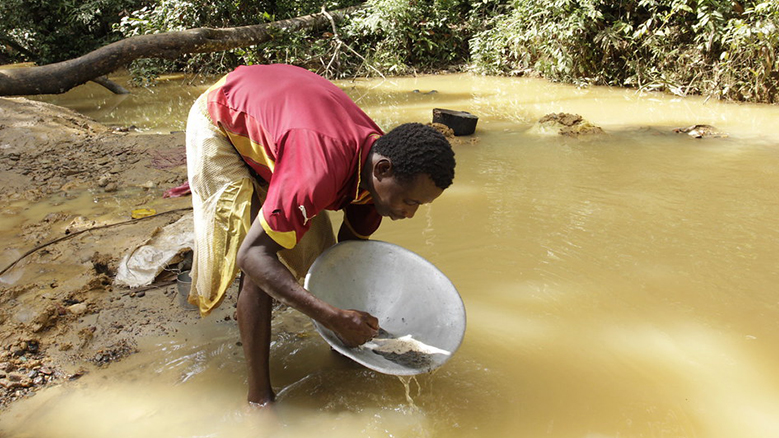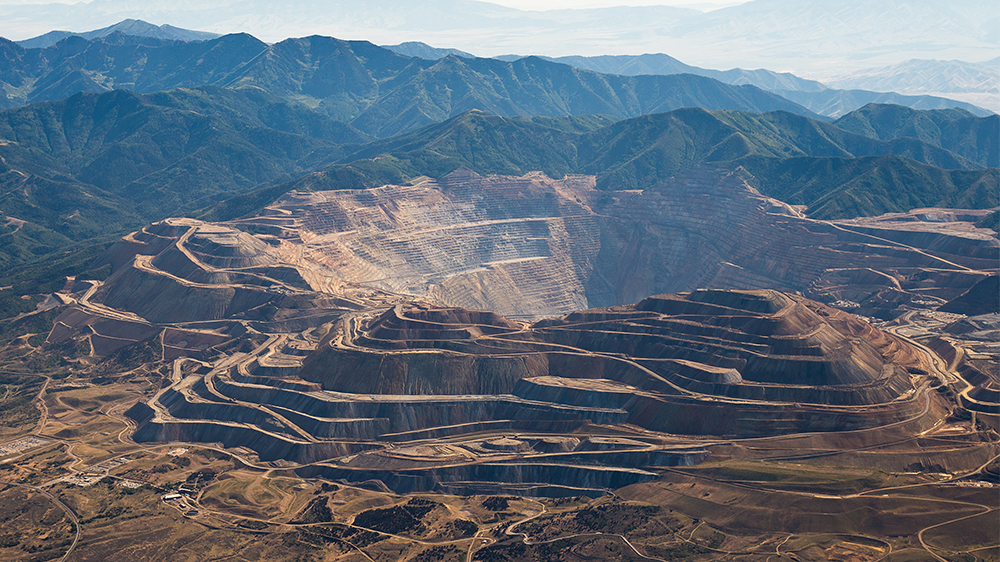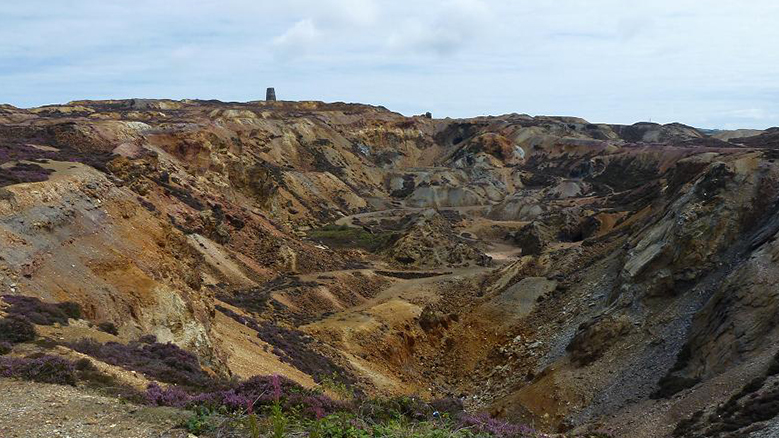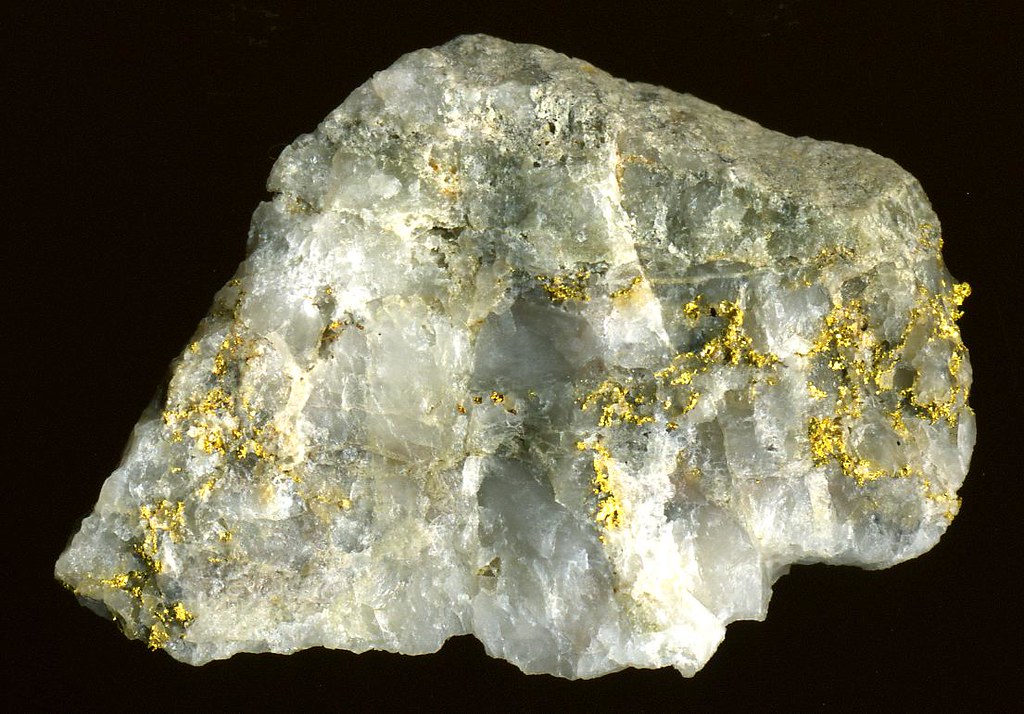Find out about The Open University's Science courses and qualifications
You may be surprised to find out that almost every rock you pick up, contains just about every natural chemical element there is. Many elements may only be present in vanishingly small, trace amounts – perhaps only one atom in a million, or even one in a billion. To extract any element from a rock, it's essential to take advantage of the geological processes that have concentrated the chemical elements you want in certain rocks. More than that, to be a viable source of any metal, a rock must not only contain a large amount of what you want, but the metal must also be in a form and in a quantity that makes financial sense to dig up, process and purify. A rock which metal can easily be extracted from to make money, is called an ore.
So, in what forms do metal ores exist? Only a few metals (like copper and gold) are found in what is called their ‘native’ form, where they aren’t combined with other elements. Most metals are combined with other elements in minerals, which are then (usually) combined with other minerals in rocks.
The places that ores are found and being formed today are determined by geological processes, which are in turn linked to the rock cycle and plate tectonics. Gold mines are not randomly distributed around the globe, but closely linked to geological processes. A few of those ore-forming processes take place in the destructive and constructive locations along plate boundaries indicated on the schematic of plate tectonics below.
 Cross section of plate tectonics.
Cross section of plate tectonics.
While gold is often discovered by panning in rivers and streams, such grains and nuggets have been eroded and transported away from their original source rocks over time. Most gold and other metals form in mineral ores related to igneous and metamorphic rocks, involving great temperatures and pressure, hence their common association with plate margin locations. Metals often occur in veins crystallised from hot hydrothermal solutions that percolate through fractures in rocks around and above subsurface granite bodies at destructive plate margins. Mineral ores have interested and fascinated humans for thousands of years.
Exploring for gold: from ancient peoples to modern mines
Finding sources of metals can be done in a number of ways. Geologists can recognise minerals or specific rock types they know contain the metal or element they are looking for. This can involve many weeks or months of studying aerial or satellite photographs and then going out into the countryside (or ‘the field’, as geologists call it), to hunt for evidence and collect rock samples. These are then brought back to the laboratory for analysis and the percentage of different elements can be worked out.
But normally it's a combination of methods. There are more indirect routes that don’t look at the elements in the rocks themselves but measure them in the water of streams and rivers.
 Small scale gold panning in the LTTC-Mandra Forest, Liberia.
Small scale gold panning in the LTTC-Mandra Forest, Liberia.
The ‘concentration’ (amount per unit volume or mass) of metals that are found dissolved (or deposited in the case of gold) in stream and river water will increase as you get closer to the source rock which contains them. This means geologists can plot maps showing these concentrations that tell us where the best places might be to find metals. Metal concentrations can also be measured from soil samples (soil geochemistry) and used to track sources. The ultimate aim is to find the source of the gold or other metal of interest.
Metal source deposits - Porphyry ore deposits
Porphyry is a textural term, describing an intrusive igneous rock that has large crystals, which are themselves surrounded by smaller crystals. An igneous rock is one that has cooled down from a molten (liquid) state and an intrusive igneous rock is one that has cooled down within the earth, surrounded by other rocks. In a case like this, the smaller crystals are called the matrix or groundmass.
Porphyry ore deposits are low grade – meaning that the amount of the element you want (in this case, gold) isn’t very high. Porphyry deposits can, however, be extremely large, so by extracting and processing large amounts of low-grade ore, enough copper or gold can be found for it to be economically worthwhile.
The need to remove very large amounts of hard igneous rocks means porphyry ore deposits weren’t mined at all until 1905, when powered shovels and rail transport for the unprocessed ore made them viable. The Bingham Canyon open pit mine in Utah, is one example. You certainly wouldn’t have wanted to dig such a big hole with only shovels and picks!
 The Bingham Canyon, porphyry copper mine, Utah, USA.
The Bingham Canyon, porphyry copper mine, Utah, USA.
The Bingham Canyon mine was one of the first porphyry copper deposits to be mined and it’s still one of the largest known ore deposits in the world. The ore body is about 2.5km long, 1.7km wide and over 1km deep. More than a billion tonnes (that’s 1,000,000,000,000 kg – a petagram!) of ore has been mined, with an average yield of only 0.9% copper. This means that 9 billion kg of copper has been extracted from the Bingham Canyon mine so far. Porphyry copper deposits can also be sources of gold and are an example of how gold occurs with other metals. This also reflects the commonalities of their formation.
Bursting balloons of copper mineralisation
Porphyry copper deposits are usually formed by small igneous intrusions – formed by hot, molten rock forcing their way through existing rocks. The ore minerals that contain the copper are mainly copper sulphides like chalcopyrite (CuFeS2) and bornite (Cu5FeS4), and they’re found in networks of veins called stockwork. Each of the veins are only a few millimetres across, so you can imagine why it isn’t efficient to try to remove just the copper minerals. In porphyry copper deposits, gold often occurs as either precipitated grains or in composite with copper-iron or copper sulphides. Gold would typically be in the order of a few – several thousand parts per million (ppm) in gold bearing minerals such as bornite or chalcopyrite.
The minerals in the veins are deposited by water being forced through the rocks. As the magma rises through the earth, it cools and solidifies first at the edges, where the hot magma is in contact with the cold rock which it is being forced through. It rises up like a balloon, because it's hotter and less dense than the rocks that surround it - just like a hot air balloon.
The magmas which form the ores also contain water, not a lot - probably only about 3% - but still enough to be important. Bubbles of hot water dissolve elements (like copper and gold) which don’t go into the minerals forming as the magma solidifies. The super-heated copper/gold-laden water is even less dense than the surrounding magma and so rises to the top of the balloon of magma. The water starts to expand and form steam and the overpressure cracks the balloon of solidifying magma, allowing the copper/gold bearing water to burst out, forcing open cracks in the rocks as it goes. As the water reaches cooler rock, it cools down and can no longer keep the copper or gold dissolved, so it’s deposited along the cracks that it’s formed.
Thinking back to locations, porphyry ore bodies tend to be either copper rich or gold rich, with some of the latter being clearly related to post subduction or post collision magmatic settings (Chiaradia 2020).
Under ancient seas – another location for metal deposits
The second main type of ore for copper, is a submarine sulphide deposit, such as that exposed at Parys Mountain in Wales. Gold is also associated with this mine.
 Parys Mountain mine, Anglesey, North Wales.
Parys Mountain mine, Anglesey, North Wales.
The Parys Mountain metal deposits on Anglesey in North Wales have been mined for almost 4,000 years, but the formation of the deposits dates back much further, to the Ordovician, over 443 million years ago. At that time, the area that we now call Anglesey, was underwater and part of an ancient ocean called Iapetus located south of the equator.
The deposits that now make up the ores at Parys Mountain and at many copper deposits worldwide, were produced in volcanoes. But not the sort of volcano you might automatically think of – these are subsea volcanoes. Most of the world’s volcanoes aren’t the cone shaped mountains with lava bursting out of them that you might imagine. Most volcanoes are found under the oceans, in long ridges which span the globe.
These volcanoes make new oceanic crust at ‘spreading centres’ distributed (mostly) from the centre of the world oceans. These are the constructive plate margins and where all new sea floor is made.
The Parys Mountain mine is actually divided into multiple zones, which have very different amounts of copper in each zone and not just copper, but other useful elements too.
Look at the table below, to see if you can answer the following question: What is the relationship between the distribution of copper and gold in the different zones at Parys Mountain? The answer is displayed beneath the table.
Parys Mountain metal distributions
|
Tonnes |
Cu % |
Pb % |
Zn % |
Ag |
Au |
||||
|
|
|
% |
g/kg |
% |
g/kg |
% |
g/kg |
g/t |
g/t |
|
Engine |
489,000 |
1.38 |
13.8 |
2.61 |
26.1 |
4.99 |
49.9 |
92.8 |
0.5 |
|
Deep Engine |
618,000 |
1.95 |
19.5 |
1.9 |
19 |
4.22 |
42.2 |
23 |
0.2 |
|
White Rock |
1,625,000 |
0.34 |
3.4 |
2.05 |
20.5 |
3.84 |
38.4 |
33 |
0.5 |
|
Garth Daniel |
299,000 |
2.06 |
20.6 |
3.07 |
30.7 |
6.43 |
64.3 |
75 |
0.2 |
|
Total |
3,031,000 |
1.01 |
10.1 |
2.21 |
22.1 |
4.36 |
43.6 |
46 |
0.5 |
The answer to the question above is: In general terms, if copper is high, gold content is low (they have a negative relationship with each other). The scarcity of gold is one of the reasons why it is so prized and expensive.
Find out more about geology and gold







Rate and Review
Rate this article
Review this article
Log into OpenLearn to leave reviews and join in the conversation.
Article reviews